2018 PEUGEOT EXPERT traction control
[x] Cancel search: traction controlPage 23 of 416
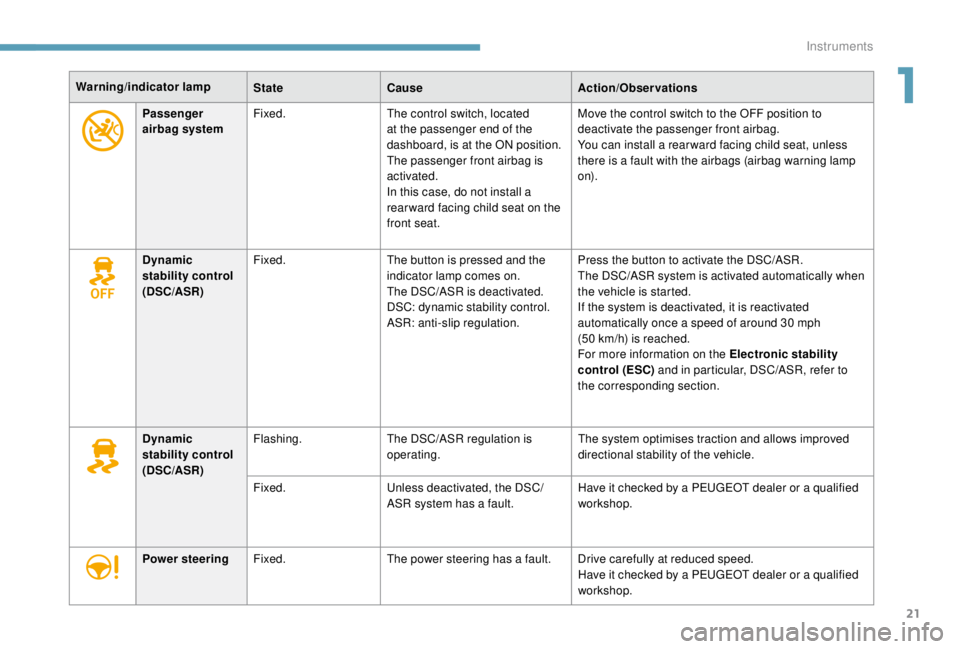
21
Passenger
airbag systemFixed.
The control switch, located
at the passenger end of the
dashboard, is at the ON position.
The passenger front airbag is
activated.
In this case, do not install a
rear ward facing child seat on the
front seat. Move the control switch to the OFF position to
deactivate the passenger front airbag.
You can install a rear ward facing child seat, unless
there is a fault with the airbags (airbag warning lamp
o n).
Warning/indicator lamp
StateCause Action/Observations
Dynamic
stability control
(DSC/ASR) Fixed.
The button is pressed and the
indicator lamp comes on.
The DSC/ASR is deactivated.
DSC: dynamic stability control.
ASR: anti-slip regulation. Press the button to activate the DSC/ASR.
The DSC/ASR system is activated automatically when
the vehicle is started.
If the system is deactivated, it is reactivated
automatically once a speed of around 30
mph
(50
km/h) is reached.
For more information on the Electronic stability
control (ESC) and in particular, DSC/ASR, refer to
the corresponding section.
Dynamic
stability control
(DSC/ASR) Flashing.
The DSC/ASR regulation is
operating. The system optimises traction and allows improved
directional stability of the vehicle.
Fixed. Unless deactivated, the DSC/
ASR system has a fault. Have it checked by a PEUGEOT dealer or a qualified
workshop.
Power steering Fixed. The power steering has a fault. Drive carefully at reduced speed.
Have it checked by a PEUGEOT dealer or a qualified
workshop.
1
Instruments
Page 129 of 416
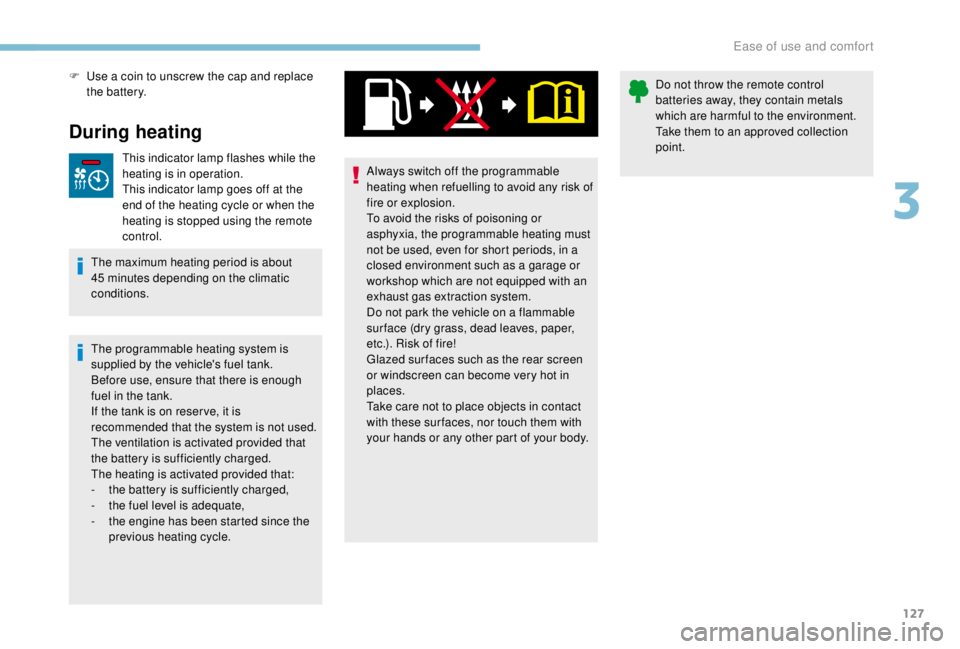
127
F Use a coin to unscrew the cap and replace the battery.
During heating
This indicator lamp flashes while the
heating is in operation.
This indicator lamp goes off at the
end of the heating cycle or when the
heating is stopped using the remote
control.
The maximum heating period is about
45
minutes depending on the climatic
conditions.
The programmable heating system is
supplied by the vehicle's fuel tank.
Before use, ensure that there is enough
fuel in the tank.
If the tank is on reser ve, it is
recommended that the system is not used.
The ventilation is activated provided that
the battery is sufficiently charged.
The heating is activated provided that:
-
t
he battery is sufficiently charged,
-
t
he fuel level is adequate,
-
t
he engine has been started since the
previous heating cycle. Always switch off the programmable
heating when refuelling to avoid any risk of
fire or explosion.
To avoid the risks of poisoning or
asphyxia, the programmable heating must
not be used, even for short periods, in a
closed environment such as a garage or
workshop which are not equipped with an
exhaust gas extraction system.
Do not park the vehicle on a flammable
sur face (dry grass, dead leaves, paper,
etc.). Risk of fire!
Glazed sur faces such as the rear screen
or windscreen can become very hot in
places.
Take care not to place objects in contact
with these sur faces, nor touch them with
your hands or any other part of your body.
Do not throw the remote control
batteries away, they contain metals
which are harmful to the environment.
Take them to an approved collection
point.
3
Ease of use and comfort
Page 147 of 416

145
Horn
F Press the central part of the steering wheel.
Electronic stability control
(ESC)
Electronic stability control integrating the
following systems:
-
a
nti-lock braking system (ABS) and
electronic brake force distribution (EBFD),
-
em
ergency braking assistance (EBA),
-
w
heel anti-slip regulation (ASR) or traction
control,
-
d
ynamic stability control (DSC).
For technical reasons, particularly
to improve the quality of PEUGEOT
CONNECT ser vices to customers, the
manufacturer reser ves the right to carry
out updates to the vehicle's on-board
telematic system.
If you benefit from the Peugeot
Connect Packs offer with the SOS and
assistance pack included, there are
additional ser vices available to you in
your MyPeugeot personal space, via the
Internet website for your country.
Definitions
Anti-lock braking system (ABS)
and electronic brake force
distribution (EBFD)
This system improves the stability and
manoeuvrability of your vehicle when braking
and contributes towards improved control on
corners, in particular on poor or slippery road
surfaces.
The ABS prevents wheel lock in the event of
emergency braking.
The electronic brake force distribution system
(EBFD) manages the braking pressure wheel
by wheel.
5
Safety
Page 148 of 416
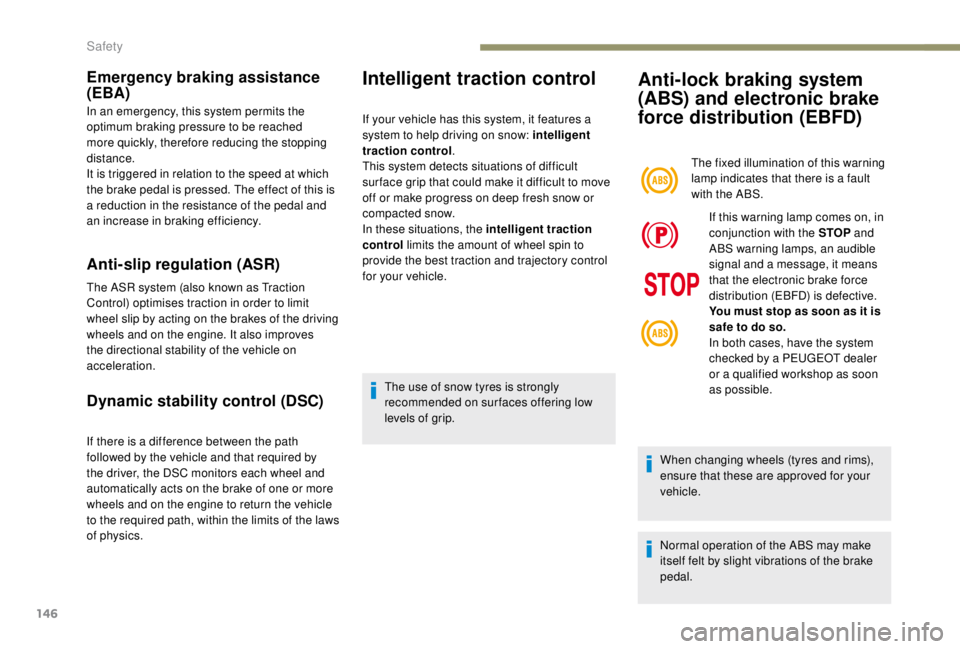
146
Emergency braking assistance
(EBA)
In an emergency, this system permits the
optimum braking pressure to be reached
more quickly, therefore reducing the stopping
distance.
It is triggered in relation to the speed at which
the brake pedal is pressed. The effect of this is
a reduction in the resistance of the pedal and
an increase in braking efficiency.
Anti-slip regulation (ASR)
The ASR system (also known as Traction
Control) optimises traction in order to limit
wheel slip by acting on the brakes of the driving
wheels and on the engine. It also improves
the directional stability of the vehicle on
acceleration.
Dynamic stability control (DSC)
If there is a difference between the path
followed by the vehicle and that required by
the driver, the DSC monitors each wheel and
automatically acts on the brake of one or more
wheels and on the engine to return the vehicle
to the required path, within the limits of the laws
of physics.
Intelligent traction control
If your vehicle has this system, it features a
system to help driving on snow: intelligent
traction control.
This system detects situations of difficult
sur face grip that could make it difficult to move
off or make progress on deep fresh snow or
compacted snow.
In these situations, the intelligent traction
control limits the amount of wheel spin to
provide the best traction and trajectory control
for your vehicle.
The use of snow tyres is strongly
recommended on sur faces offering low
levels of grip.
Anti-lock braking system
(ABS) and electronic brake
force distribution (EBFD)
The fixed illumination of this warning
lamp indicates that there is a fault
with the ABS.If this warning lamp comes on, in
conjunction with the STOP and
ABS warning lamps, an audible
signal and a message, it means
that the electronic brake force
distribution (EBFD) is defective.
You must stop as soon as it is
safe to do so.
In both cases, have the system
checked by a PEUGEOT dealer
or a qualified workshop as soon
as possible.
When changing wheels (tyres and rims),
ensure that these are approved for your
vehicle.
Normal operation of the ABS may make
itself felt by slight vibrations of the brake
pedal.
Safety
Page 150 of 416
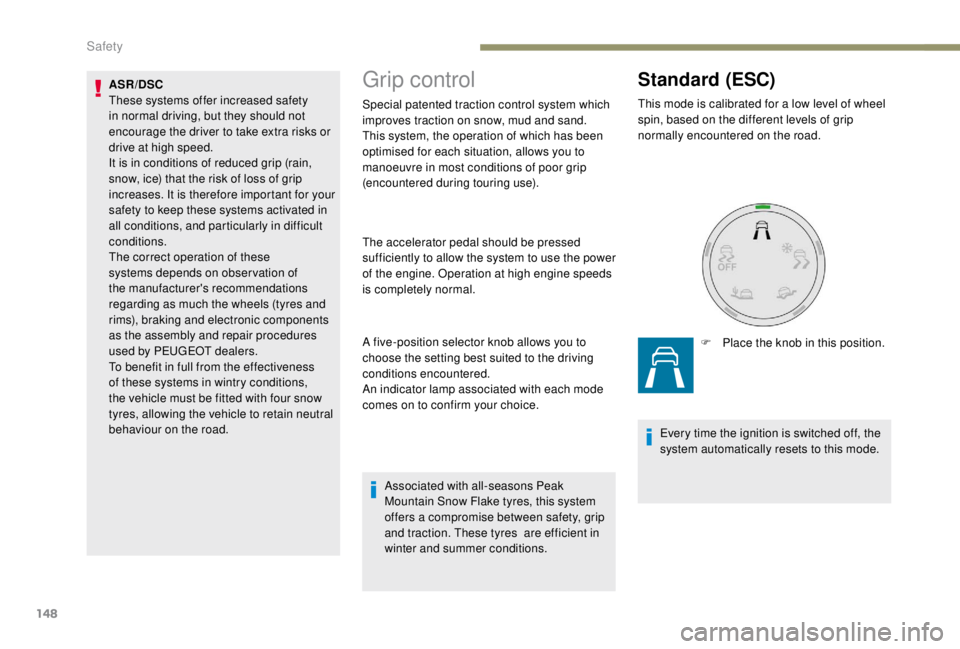
148
Grip control
Special patented traction control system which
improves traction on snow, mud and sand.
This system, the operation of which has been
optimised for each situation, allows you to
manoeuvre in most conditions of poor grip
(encountered during touring use).
The accelerator pedal should be pressed
sufficiently to allow the system to use the power
of the engine. Operation at high engine speeds
is completely normal.
Standard (ESC)
F Place the knob in this position.
ASR/DSC
These systems offer increased safety
in normal driving, but they should not
encourage the driver to take extra risks or
drive at high speed.
It is in conditions of reduced grip (rain,
snow, ice) that the risk of loss of grip
increases. It is therefore important for your
safety to keep these systems activated in
all conditions, and particularly in difficult
conditions.
The correct operation of these
systems depends on obser vation of
the manufacturer's recommendations
regarding as much the wheels (tyres and
rims), braking and electronic components
as the assembly and repair procedures
used by PEUGEOT dealers.
To benefit in full from the effectiveness
of these systems in wintry conditions,
the vehicle must be fitted with four snow
tyres, allowing the vehicle to retain neutral
behaviour on the road.
A five-position selector knob allows you to
choose the setting best suited to the driving
conditions encountered.
An indicator lamp associated with each mode
comes on to confirm your choice.
Associated with all-seasons Peak
Mountain Snow Flake tyres, this system
offers a compromise between safety, grip
and traction. These tyres are efficient in
winter and summer conditions. This mode is calibrated for a low level of wheel
spin, based on the different levels of grip
normally encountered on the road.
Every time the ignition is switched off, the
system automatically resets to this mode.
Safety
Page 193 of 416

191
If your vehicle has an automatic gearbox,
never try to start the engine by pushing
the vehicle.
Automatic operation
F Select position D for automatic
changing of the six gears.
The gearbox then operates in auto-adaptive
mode, without any inter vention on the part
of the driver. It continuously selects the most
suitable gear according to the style of driving,
the profile of the road and the load in the
vehicle. For maximum acceleration without
touching the selector, depress
the accelerator fully (kick-down).
The gearbox changes down
automatically or holds the gear
selected until the maximum engine
speed is reached.
When braking, the gearbox changes down
automatically to provide effective engine
braking. Never select position N while the vehicle
is moving.
Never select position P or R unless the
vehicle is completely stationary.
Temporary manual control
of gear changes
You can temporarily take over control of gear
changes using the "
+" and " -" steering mounted
controls. If the engine speed allows, the gear
change is carried out. For better safety, the gearbox will not shift up if
you release the accelerator sharply. This function allows you to anticipate certain
situations, such as overtaking another vehicle
or approaching a bend in the road.
After a few moments with no action on the
control paddles, the gearbox returns to
automatic operation.
Self-sufficient traction
(moving without using the
accelerator)
This function facilitates manoeuvring of the
vehicle at low speed (when parking, in traffic
jams, etc.).
With the engine at idle, parking brake released
and position D
, M or R selected, the vehicle
moves as soon as you take your foot off the
brake pedal (even without depressing the
accelerator).
As a safety measure (children on board),
never leave the vehicle with the engine
running and the doors closed.
6
Driving
Page 407 of 416

309
M
N
O
Markings, identification .................................305
Mat ........................................................ 108, 181
Memorising a speed
..................................... 2
02
Menu
............................................................... 13
Menu, main
....................................................... 4
M
enus (audio)
........................................ 4-5, 4-6
Messages
........................................................ 32
Messages, quick
............................................. 3
2
Mirror, rear view
........................................ 86 - 87
Mirrors, door ...............85-86, 121-122, 225-226
Mirror, vanity
................................................. 109
Misfuel prevention
......................................... 238
Moduwork .................................................. 94-97
Mountings, Isofix
....................16 6 , 16 9 -170, 172
MP3
CD ........................................................... 10
Net, cargo.................................................. 94-97
Net, high load retaining
..........................113 -114
Number plate lamps
..............................279, 281
Oil change
............................................. 24
8-249
Oil consumption
.................................... 248-249
Oil, engine
....................................... 15, 248-249
On-board tools
...................................... 258-260
Opening 90/180/250°
...................................... 78
Opening the bonnet
...................................... 246
Opening the boot
............................... 39, 50, 80
Opening the doors
............39, 50, 63, 66 -70, 79
Opening to 180°
......................................... 7
7-78
LLabels ........................................................ 7, 1 0 5
Labels, identification ..................................... 305
Lane Departure Warning System (LDWS)
.................................... 26, 222
Level, brake fluid
........................................... 249
Level, Diesel additive
............................250-251
Level, engine coolant
........................29 -30, 249
Level, engine oil
.............................. 30, 248-249
Level, headlamp wash
..........................140, 249
Level, power steering fluid
............................249
Levels and checks
..............................
..247, 249
Level, screenwash fluid
........................14
0, 249
Lighting, cornering
................................. 13 4 -13 5
Lighting dimmer
.............................................. 34
Lighting, exterior
........................................... 13 0
Lighting, guide-me home
.......................13 3 -13 4
Lighting, welcome
......................................... 13 4
Loading
......................................................... 243
Loading area fittings
..................................... 112
Load reduction mode
.................................... 243
Load restraint
...............................
.................112
Locating your vehicle
...................................... 43
Locking
.............................. 4
2, 46, 49, 54-55, 60
IIdentification, vehicle .................................... 305
Ignition ................ ............................. 181, 183, 31
Ignition on ...................................................... 183
Immobiliser, electronic
......................44, 60, 185
Indicator, AdBlue
® range ................................. 31
Indicator, coolant temperature ..................29-30
Indicator, engine oil level
................................ 30
Indicator lamps, operation
.............................. 13
I
ndicators, direction
...................................... 132
Inflating tyres
................................................ 305
Inflating tyres (using the kit)
.................. 26
0-265
Instrument panel
............................................. 10
Intelligent Traction Control
............................ 14 6
Internet browser
.............................................. 18
I
SOFIX
........................................... 16 8 -170, 172Key
..................................
39 - 42, 60, 63 - 64, 178
Key, electronic
.................................
39, 183 -18 4
Keyless Entry and Starting
..........
46, 50 - 61, 63 - 64, 181-182, 185
Key with remote control
...............
4
2, 44, 54-55,
178 , 18 5
Kit, hands-free
.................... 2
8 -2 9, 15 -16 , 11-12
Kit, temporary puncture repair
.............. 2
59-265
K
JJack ...............................
............112, 266, 26, 10
Jump starting ................................................ 288Locking from the inside
.............................61- 62
Low fuel level ...................................1
6, 237-238
Lumbar
............................................................88
Headlamps, automatic dipping
....... 25, 13 5 -13 6
Headlamps, automatic illumination ... 13
0, 132-13 4
Headlamps, dipped beam
........................ 2
5 -26, 130, 273 -274, 276
Headlamps, halogen
............................. 273-275
Headlamps, main beam
........................ 2
5 -26, 130, 273, 275 -276
Headlamps, Xenon
............................... 273, 276
Headlamp wash
..............................
.............. 140
Head restraints, front
................................ 91, 93
Head restraints, rear
....................................... 99
Head-up display
.................................... 20
0-201
Heated bench seat
.......................................... 93
Heating
.................................... 11
5 -11 6 , 12 3 -12 7
Heating, additional
........................... 81, 125 -127
Heating, programmable
................... 81, 125 -127
Hill start assist
............................................... 18 6
Horn ............................................................... 145
.
Alphabetical index
Page 409 of 416
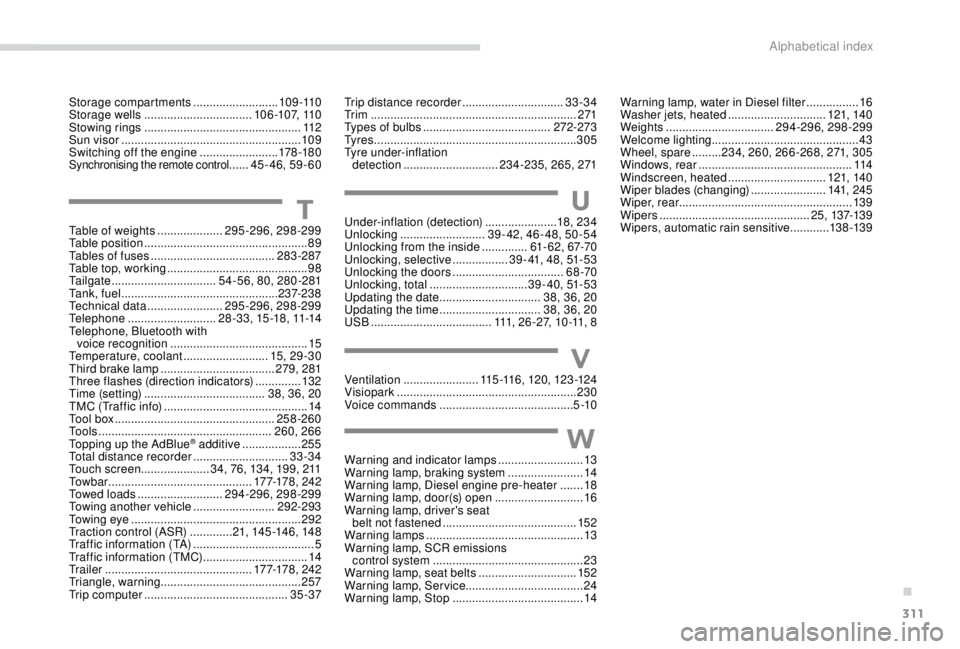
311
Table of weights ....................29 5-296, 298-299
Table position .................................................. 89
Tables of fuses
...................................... 283-287
Table top, working
........................................... 98
Tailgate
................
................54-56, 80, 280 -281
Ta n k , f u e l
................................................ 237-238
Technical data
.......................295-296, 298-299
Telephone
........................... 2
8 - 3 3 , 15 -18 , 11-14
Telephone, Bluetooth with voice recognition
.......................................... 15
T
emperature, coolant
..........................15, 29 - 3 0
Third brake lamp
................................... 279, 281
Three flashes (direction indicators)
.............. 13
2
Time (setting)
..................................... 38, 36, 20
TMC (Traffic info)
............................................ 14
T
ool box
................
................................. 258-260
To o l s
..................................................... 260, 266
Topping up the AdBlue
® additive .................. 255
Total distance recorder
............................. 33-34
Touch screen ..................... 34, 76, 134, 199, 211
To w b a r
...............................
............. 17 7-178 , 242
Towed loads
.......................... 294-296, 298-299
Towing another vehicle
......................... 292-293
Towing eye
.................................................... 292
Traction control (ASR)
............. 21, 145 -14 6, 148
Traffic information (TA)
..................................... 5
Traffic information (TMC)
................................ 14
Tr a i l e r
...............
.............................. 17 7-178 , 242
Triangle, warning ........................................... 257
Trip computer
............................................ 35 -37
T
V
W
U
Ventilation ....................... 115 -116, 120, 123 -124
Visiopark ....................................................... 23
0
Voice commands
......................................... 5 -10
Warning and indicator lamps
.......................... 13
W
arning lamp, braking system
.......................14
Warning lamp, Diesel engine pre-heater
.......18
Warning lamp, door(s) open
...........................16
Warning lamp, driver's seat belt not fastened
...............................
..........152
Warning lamps
................................................ 13
Warning lamp, SCR emissions control system
.............................................. 23
Warning lamp, seat belts
..............................152
Warning lamp, Service ....................................24
Warning lamp, Stop
........................................ 14
Under-inflation (detection)
......................
18, 234
Unlocking
..........................
39-42, 46-48, 50-54
Unlocking from the inside ..............
61- 62, 67-70
Unlocking, selective
.................
39 - 41, 48, 51-53
Unlocking the doors
.................................. 6
8 -70
Unlocking, total
..............................
3 9 - 4 0 , 51- 5 3
Updating the date
............................... 3
8, 36, 20
Updating the time
............................... 3
8, 36, 20
USB
.....................................
111, 2 6 - 2 7, 1 0 -11, 8
Storage compartments
..........................
109 -110
Storage wells
.................................
10 6 -107, 110
Stowing rings
................................................
112
Sun visor
...............................
........................
109
Switching off the engine
........................
178 -18 0
Synchronising the remote control ......45 - 46, 59 - 60 Trip distance recorder
...............................
33
-34
Tr i m
...............
................................................
271
Types of bulbs
.......................................
2
72-273
Ty r e s
..............................................................
305
Tyre under-inflation detection ............................. 23
4-235, 265, 271Warning lamp, water in Diesel filter
................
16
W
asher jets, heated
..............................
121, 14 0
Weights
...............
..................
294-296, 298-299
Welcome lighting ............................................. 43
Wheel, spare ......... 23 4, 260, 266-268, 271, 305
Windows, rear ...............................................114
Windscreen, heated
..............................121, 14 0
Wiper blades (changing)
.......................141, 2 4 5
Wiper, rear ..................................................... 13 9
Wipers
..............................................25, 137-13 9
Wipers, automatic rain sensitive
............13 8 -13 9
.
Alphabetical index